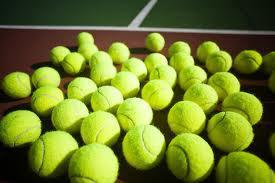 I'm a big advocate for knowing the rules of tennis. You can easily and wrongly lose points by not knowing the rules. (And you can just as easily win them by being the one person on the court who actually knows the rules!)
I'm a big advocate for knowing the rules of tennis. You can easily and wrongly lose points by not knowing the rules. (And you can just as easily win them by being the one person on the court who actually knows the rules!) And there are definitely some weird rules in tennis that you should know. So here's one that you might not have seen played out yet. This has happened to me in at least one match and I've seen it in several others so I'm guessing that if you haven't come up against it yet, you soon will.
You're at the base line. Your opponent hits a ball that is clearly sailing out. It's going to hit the back fence. There is no doubt about it. You know it and your opponent knows it. So you call it out before it lands out - not all that great of etiquette on your part but you do it anyway. However, before it lands, you catch it in your hand. Or maybe you catch it on your racquet (if you're really good). Or you hit it away with your racquet. Or it actually hits your body before it lands because you don't get out of the way fast enough (this would be me). Anyway, the point is - although the ball was going out, you somehow touch the ball before it bounces out.
Well, guess what? You just lost the point.
Why? First, you need to look at Rule 11 of the ITF Rules of Tennis which states: "Unless a fault or a let is called, the ball is in play from the moment the server hits the ball, and remains in play until the point is decided." Not too helpful because the rule itself doesn't address our specific situation. But USTA Comment 11.1 does:
Is a point decided . . . when an apparently bad shot passes over the baseline or sideline? No. A ball is in play until it bounces twice or lands outside the court, hits a permanent fixture, or hits a player. . . .Rule 24 also addresses this scenario. This rule talks about when a player loses a point and Rule 24, Case 8 explains:
Case 8: A player standing outside the court hits the ball or catches it before it bounces and claims the point because the ball was definitely going out of the correct court.The Code even weighs in on this situation. Section 41 states: "Catching a ball. If a player catches a ball before it bounces, the player loses the point regardless of where the player is standing." And Code Section 6 reminds us that the opponent always gets the benefit of the doubt.
Decision: The player loses the point, unless it is a good return, in which case the point continues.
Here's how I saw this played out in a ZAT-level match involving 12 year-olds. A kid hit a return that was sailing out. But, before it bounced out, it hit his opponent who just didn't get out of the way fast enough. The kid then called the score, giving that point to his opponent presumably because the kid knew his ball was going out. The opponent, however, who knew the proper application of the rule, tells the kid, "No, its your point because it hit me." But the kid won't take the point because he knows his ball was going out and he doesn't know the rule in this situation. So, he wound up wrongly giving the point to his very nice, very upstanding opponent. I was involved because after the match, the kid's mom tracked me down (I was training as a USTA official) and asked me to explain the rule to the kid.
Here's how I explained it: losing the point in this situation actually makes a lot of sense. Even though a ball looks like it is going out, it isn't actually out until it bounces out. Because who knows what weird spin you might put on it? Or what strange wind might blow it back in? Or even what never-before-seen shift of the Earth's axis might occur at that exact moment? Until the ball bounces out, there is always some slight, miniscule chance it might bounce in and your opponent must give you benefit of the doubt on that and make sure the ball is really out.
The bottom line - if this happens to you, let the ball bounce out and then, immediately, call it out. Act any sooner and you may lose the point.
Interested in other weird tennis rules? See this post for a good example: "Weird" Tennis Rules: Reaching Over The Net.

© Kim Selzman 2012 All Rights Reserved

